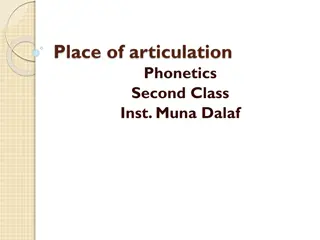Exploring Clarinet Articulation: Techniques and Strategies
Delve into the nuances of clarinet articulation with the University of North Texas faculty as they discuss the importance of slurring, tonguing, and airflow. Learn about effective breathing techniques, tongue positioning, and the role of air in creating a strong sound. Discover valuable resources for developing articulation skills and optimizing performance.
- Clarinet Articulation
- University of North Texas
- Breathing Techniques
- Tonguing Strategies
- Music Education
Download Presentation

Please find below an Image/Link to download the presentation.
The content on the website is provided AS IS for your information and personal use only. It may not be sold, licensed, or shared on other websites without obtaining consent from the author. Download presentation by click this link. If you encounter any issues during the download, it is possible that the publisher has removed the file from their server.
E N D
Presentation Transcript
ArticulationM ore than Just Tonguing University of North Texas Clarinet Faculty Daryl Coad Deborah Fabian Kimberly Cole Luevano John Scott
In the beginning was the Slur . Does your clarinet section sound better when they slur or when they tongue? Nothing works without air Efficiency, balance and relaxation Breathing: tummy, down/out/away Shoulders: circles not up/down More on this from Daryl Coad momentarily .
Once the tone and blowing have been established, add the tongue. Tip to tip is the most common technique. Actually: Top of the tip of the tongue to the bottom of the tip of the reed. hah-tah or hah-dah perhaps hAH-tAH or hAH-dAH hah-dah-dah-dah or hAH-dAH-dAH-dAH It s all about frogs catching flies!
The tongue either releases (the first notes) or interrupts the sound NB: These are very different techniques! Three parts to a sound: Beginning Middle End Start Tone Stop Attack* Duration Release* *Why do we use these words when we really release to attack and attack to release?
*Why do we use these words when we really release to attack and attack to release? Tonguing is not a military battle: forward/ATTACK, back/RETREAT (RELEASE) Tonguing is about the backstroke (the release of air): The tongue is not a rivet gun.
Air Strategies Everything originates with the wind. Good sound is first and foremost a function of a strong wind column. Of course voicing, tongue position and embouchure structure matter, but without the wind, NONE of it matters. Without the wind, the kite will not fly. Good articulation is 95% Wind/Voicing/Embouchure Structure + 5% tongue . Not vice-versa.
Air resources Helpful tools your students already have: Barrel/Bell Swab BAT-BERP Website Breathing Awareness Tool (BAT) for $29.95, distributed by BERP Company (Buzz Extension and Resistance Piece). http://www.berp.com/product/bat/ Windsong Press Website: This site contains all of the devices Arnold Jacobs used to train wind players to use their full capacity. http://www.windsongpress.com/breathing%20devices/breathing%20devic es.htm
Embouchure Structure Developed embouchure structure is critical to articulation success.
Embouchure essentials: Pressure around mouthpiece remains constant all the time. Mouthpiece is snug against top teeth; facial muscles hold and form a firm-yet peaceful-seal around the mouthpiece. Embouchure should be set before blowing. (bottom lip is often too loose or unengaged.) Recommend setting embouchure first before inserting mouthpiece. Can students form embouchure without clarinet?
Embouchure essentials, continued: Jaws and lips do not move with tongue. Use of a mirror is the best way to detect unnecessary movement. Facial appearance should be the same in all registers and articulations. Chewing or visible movement is undesirable. Movement in jaws or lips is indicative of a more serious issue requiring attention. Throat stays open and relaxed as tongue moves. Use soda straw to help students develop awareness. Ideally no throat movement. Can indicate tongue is moving too much or may not be in ideal shape for optimal sound.
Common embouchure problems: Biting : excessive jaw pressure, not enough lip pressure/structure Solutions? Double lip: use to develop uniform and balanced muscular structure Embouchure Sprints with pencil to help develop/ understand the desirable amount of space between back molars. Mouthpiece angle: should be about 45 degrees. (though depends on facial structure) Not enough mp in mouth How to find appropriate placement?
Once embouchure is well established: Tip to tip Actually: Top of the tip of the tongue to the bottom of the tip of the reed. How to find tip of tongue? scratch with fingernail magic marker coffee cup lip
Common articulation problems? BEWARE these typical student survival techniques: Coughing Roof of the mouth .. Tonguing the bottom lip? Too much tongue surface
VOICING THE OFTEN NEGLECTED IMPORTANCE OF THE TONGUE IN SHAPING THE CLARINET TONE AND PITCH The tongue plays an extremely important role in tonal production and tuning by controlling the air flow, speed, and direction of the breath to create a colorful, warm, resonant sound. Successful tonal and pitch production comes with understanding proper tongue position as well as a supported air stream and a correctly formed embouchure that has NOT been trained to bite.
We have numerous choices using both embouchure and tongue position in both tonal and pitch production.
Techniques to help identify correct position of the tongue in the mouth when voicing: Developing a good tonal concept Using language to understand the choices we have in voicing Using the voice to demonstrate the many choices we have for tongue placement Italian style articulation You can demonstrate even more with the mouthpiece and barrel!
WHY DO STUDENTS OFTEN GET A BETTER SOUND SLURRING RATHER THAN TONGUING? TONGUE PLACEMENT ON THE REED Tongue and slur with the same tongue position/voicing. It is most important that the desired position of the tongue while voicing remain the same while articulating.
In conclusion: Points to remember to help your students: 1. Have appropriate equipment especially mouthpiece/reed combination 2. Develop a good concept of clarinet tone 3. Well supported airstream 4. Correctly formed embouchure 5. Correct position of the tongue for voicing 6. Keep the same desired voicing position of the tongue while articulating
Questions? What questions do you have for us? What are your experiences with your own students?
How can we help? Please feel free to contact us if we can be of assistance: Daryl.Coad@unt.edu Deborah.Fabian@unt.edu Kimberly.Cole@unt.edu John.Scott@unt.edu clarinet.music.unt.edu
UNT ClarEssentials Summer Workshops for High School and Middle School Students: High school: June 22-25, 2016 (UNT Campus) Middle School: June 6-8, 2016 (Denton) June 13-15, 2016 (Frisco) clarinet.music.unt.edu/claressentials























